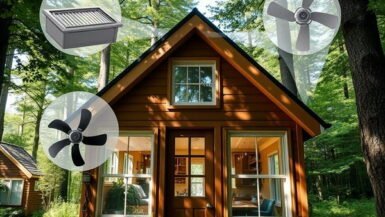As the popularity of sustainable tiny homes continues to grow, one crucial aspect that demands our attention is energy efficiency. A key factor contributing to this is insulation, which plays an essential role in maintaining a comfortable and energy-efficient living space. In this article, we will delve into the importance of insulation in tiny homes, discuss the various types of insulation materials available, and provide expert guidance on selecting the most suitable insulation for your space. By understanding the significance of proper insulation, homeowners can make informed decisions that not only save on energy costs but also create a more sustainable and eco-friendly dwelling. Join us as we explore the vital role insulation plays in optimizing energy efficiency within the realm of tiny home living.
Types of Eco-Friendly Insulation Materials for Tiny Homes
Selecting the right insulation material for your tiny home is crucial in achieving optimal energy efficiency. With the growing interest in sustainable living, the market now offers a variety of eco-friendly insulation materials that are both effective and environmentally responsible. In this section, we will explore some of the most popular and innovative green insulation options for tiny homes, helping you make an informed decision when it comes to building an energy-efficient and comfortable living space.
Natural Sheep’s Wool Insulation
One of the most sustainable insulation options available today is natural sheep’s wool. This renewable resource is not only biodegradable but also offers excellent thermal and acoustic insulation properties. Its ability to absorb and release moisture without losing its insulating capabilities makes it a popular choice among tiny home enthusiasts who seek a healthier indoor environment. Additionally, sheep’s wool insulation is resistant to mold, mildew, and pests, ensuring longevity and low maintenance.
Recycled Denim Insulation
Recycled denim insulation, also known as cotton batt insulation, is made from post-industrial and post-consumer denim waste. It is an excellent choice for those looking to reduce their ecological footprint while enjoying the benefits of superior thermal insulation. This sustainable material is free from harmful chemicals, making it safe for both the environment and the occupants of the tiny home. Furthermore, it is easy to work with and can be easily cut and shaped, making installation a simple process for DIY enthusiasts.
Cellulose Insulation
Derived primarily from recycled newspaper, cellulose insulation is a highly eco-friendly and cost-effective option. It has a high R-value, which means it is highly effective in preventing heat transfer and providing excellent thermal insulation. This material can be blown-in or applied as a wet spray, making it suitable for various applications in tiny homes, including walls, ceilings, and floors. Cellulose insulation is also fire-resistant and pest-resistant, contributing to the overall safety and durability of your tiny home.
Structural Insulated Panels (SIPs)
For those seeking a prefabricated insulation solution, structural insulated panels (SIPs) are an excellent choice. SIPs consist of an insulating foam core sandwiched between two structural facings, typically made from oriented strand board (OSB) or plywood. This combination provides excellent thermal performance, structural strength, and airtightness, making it highly suitable for tiny home construction. SIPs are available with various eco-friendly core materials, such as expanded polystyrene (EPS), polyurethane (PUR), and polyisocyanurate (PIR), allowing homeowners to choose the best option for their specific needs and preferences.
As the demand for sustainable tiny homes continues to rise, the availability of eco-friendly insulation materials is expanding. By carefully considering the environmental impact and performance of these materials, homeowners can make informed decisions that contribute to the overall energy efficiency and comfort of their tiny living spaces.
Insulation Techniques to Maximize Energy Efficiency in Small Spaces
Implementing effective insulation techniques is key to achieving maximum energy efficiency in tiny homes. Insulation plays a vital role in maintaining a comfortable indoor temperature while minimizing energy consumption. In this section, we will discuss various insulation techniques that can be used to optimize energy efficiency in small spaces, ensuring that your tiny home remains cozy and environmentally friendly.
Continuous Insulation for Improved Thermal Performance
One of the most effective ways to enhance energy efficiency in a tiny home is by employing continuous insulation. This method involves installing insulation without any gaps or breaks, creating an uninterrupted thermal barrier that prevents heat transfer. Continuous insulation can be achieved using various materials, including rigid foam boards, spray foam, or insulated sheathing. By eliminating thermal bridging, this technique significantly reduces energy loss and contributes to a more comfortable living environment.
Airtightness and Vapor Barriers
Ensuring airtightness is crucial in maximizing the energy efficiency of your tiny home. By sealing air leaks, you can reduce drafts and prevent the infiltration of outdoor air, leading to lower heating and cooling costs. A vapor barrier, such as a polyethylene sheet or a specialized paint, can be installed on the warm side of the insulation to control moisture migration and reduce the risk of condensation-related issues. Combining airtightness with proper insulation creates a more energy-efficient and comfortable living space.
Strategic Placement of Insulation
The placement of insulation within the tiny home’s structure plays a significant role in enhancing energy efficiency. Insulating the roof, walls, and floors is essential to maintain a comfortable indoor temperature. In colder climates, it may be necessary to increase the insulation in the roof and walls to reduce heat loss. Additionally, insulating around windows, doors, and other openings will help to minimize drafts and improve the overall thermal performance of your tiny home.
Optimizing Window Design for Energy Efficiency
Windows can be a significant source of heat loss or gain in tiny homes. Therefore, it is essential to choose energy-efficient windows and install them correctly. Double or triple-glazed windows with low-emissivity coatings can help minimize heat transfer and improve insulation. Additionally, proper sealing and caulking around windows can prevent drafts and further enhance the energy efficiency of your tiny home.
Consider Passive Solar Design Principles
Integrating passive solar design principles into your tiny home can help optimize energy efficiency and reduce heating and cooling costs. By strategically positioning your home and windows, you can harness the sun’s energy to heat your living space during the winter months while minimizing heat gain in the summer. Combining passive solar design with effective insulation techniques can result in significant energy savings and a more sustainable tiny home.
By carefully considering and implementing these insulation techniques, homeowners can create a comfortable and energy-efficient living space while reducing their environmental impact. Taking the time to invest in proper insulation will not only save on energy costs but also contribute to the overall sustainability and comfort of your tiny home.
The Role of Proper Insulation in Reducing Tiny Home Energy Costs
As homeowners continue to seek ways to minimize their environmental footprint and reduce energy costs, the importance of proper insulation in tiny homes cannot be overstated. In this section, we will examine how investing in the right insulation materials and techniques can significantly impact energy consumption, leading to lower utility bills and a more sustainable living space. In addition, we will explore some practical tips to help you make the most of your insulation efforts, ensuring that your tiny home remains energy-efficient and cost-effective.
Reduced Heating and Cooling Expenses
A well-insulated tiny home can substantially cut down on heating and cooling costs. By minimizing heat transfer through walls, ceilings, and floors, effective insulation helps maintain a comfortable indoor temperature, reducing the need for energy-intensive heating and cooling systems. As a result, homeowners can enjoy lower energy bills and a reduced reliance on non-renewable energy sources.
Increased Longevity of HVAC Systems
Proper insulation not only lowers energy costs but also extends the lifespan of heating, ventilation, and air conditioning (HVAC) systems. When a tiny home is well-insulated, the HVAC system does not have to work as hard to maintain the desired temperature. This reduced workload can help prevent wear and tear on the equipment, saving homeowners money on maintenance and replacement costs in the long run.
Improved Indoor Air Quality and Comfort
Investing in high-quality insulation can also contribute to a healthier and more comfortable living environment. By sealing air leaks and preventing drafts, insulation can help maintain consistent indoor temperatures and humidity levels, resulting in better air quality and reduced allergens. This improvement in indoor comfort not only enhances the overall living experience but can also reduce the need for additional heating or cooling, further lowering energy costs.
Maximizing the Benefits of Renewable Energy Sources
For tiny home owners who have embraced renewable energy sources, such as solar panels or wind turbines, proper insulation can help maximize the return on their investment. By reducing the energy demand of the home, insulation allows the generated renewable energy to be used more efficiently, decreasing the reliance on grid-supplied electricity and further reducing energy costs.
Energy Efficiency and Home Value
Finally, it’s worth noting that a well-insulated and energy-efficient tiny home can have a positive impact on its overall value. As energy costs and environmental concerns continue to rise, energy efficiency is becoming an increasingly attractive feature for potential buyers. By investing in proper insulation, homeowners can not only enjoy immediate cost savings but also increase the long-term value of their property.
By understanding the critical role insulation plays in reducing energy costs and implementing the appropriate materials and techniques, tiny home owners can create a more sustainable, comfortable, and cost-effective living space. As a result, the importance of proper insulation in tiny homes should not be underestimated, as it directly contributes to the overall energy efficiency and financial benefits of this increasingly popular housing option.
How Insulation Contributes to Indoor Comfort and Climate Control in Tiny Homes
Proper insulation plays a crucial role in maintaining indoor comfort and climate control in tiny homes. By effectively managing heat transfer and air infiltration, insulation helps to create a comfortable living environment with stable indoor temperatures and humidity levels. In this section, we will discuss how insulation contributes to indoor comfort and climate control, highlighting the benefits of investing in the right insulation materials and techniques for your tiny home.
Stabilizing Indoor Temperatures
One of the primary benefits of insulation is its ability to stabilize indoor temperatures. By reducing heat transfer through walls, ceilings, and floors, insulation helps to keep a tiny home warm in the winter and cool in the summer. This consistent indoor temperature not only contributes to a more comfortable living environment but also reduces the need for energy-intensive heating and cooling systems, leading to lower energy consumption and costs.
Minimizing Air Infiltration
Air infiltration, or drafts, can significantly impact the comfort and energy efficiency of a tiny home. By sealing gaps and cracks in the building envelope, insulation helps to minimize air infiltration, preventing drafts and the infiltration of outdoor air. This airtightness not only improves indoor comfort but also contributes to better climate control, as it reduces the workload on heating and cooling systems.
Regulating Indoor Humidity
Insulation can also play a vital role in regulating indoor humidity levels. By controlling moisture migration and preventing condensation, insulation helps to maintain a healthy and comfortable indoor environment. Maintaining appropriate humidity levels can also prevent the growth of mold and mildew, which can cause health issues and damage to the home’s structure.
Enhancing Acoustic Comfort
Another often-overlooked benefit of insulation is its ability to improve acoustic comfort by reducing noise transmission. Certain types of insulation materials, such as sheep’s wool and recycled denim, offer excellent sound-absorbing properties, helping to create a quieter and more peaceful living environment. This can be particularly beneficial in tiny homes, where space constraints can make it challenging to escape noise from neighboring rooms or the outdoors.
Supporting Passive Solar Design
Insulation can also contribute to indoor comfort and climate control by supporting passive solar design principles. By strategically positioning your tiny home and windows to harness the sun’s energy, you can optimize the benefits of solar heat gain in the winter months while minimizing overheating in the summer. Proper insulation helps to retain this solar heat, further enhancing the overall energy efficiency and comfort of your tiny home.
Investing in the right insulation materials and techniques is essential in creating a comfortable and energy-efficient tiny home. By effectively managing heat transfer, air infiltration, humidity, and noise, insulation contributes to a more enjoyable living environment while also promoting long-term sustainability and cost savings. As the popularity of tiny homes continues to rise, understanding the importance of insulation for indoor comfort and climate control is key to making the most of this increasingly popular housing option.
Case Studies: Real-life Examples of Energy-Efficient Tiny Homes with Superior Insulation
In this section, we will explore several real-life examples of tiny homes that have successfully implemented superior insulation techniques to achieve outstanding energy efficiency. These case studies demonstrate the practical application of various insulation materials and methods, highlighting the effectiveness of proper insulation in creating comfortable, sustainable, and cost-effective living spaces in tiny homes.
Earthship-Inspired Tiny Home: Sustainable Living with Natural Materials
One fascinating example of a well-insulated tiny home is an Earthship-inspired dwelling built by a couple in British Columbia, Canada. This unique, off-grid home incorporates natural and reclaimed materials such as straw bales, tires, and recycled bottles to create an energy-efficient and environmentally friendly living space. The straw bales provide excellent thermal insulation, while the tire walls store and release heat, helping to maintain a stable indoor temperature. This innovative approach to insulation demonstrates the potential for combining sustainable materials with effective insulation techniques to create a comfortable and eco-friendly tiny home.
High-Performance Tiny House on Wheels: A Mobile Solution for Energy Efficiency
A noteworthy example of a well-insulated tiny home on wheels is the high-performance model designed by Tiny House Chattanooga. This mobile dwelling features structural insulated panels (SIPs) with an expanded polystyrene (EPS) core, providing superior thermal performance and airtightness. The use of SIPs not only reduces energy costs but also minimizes construction waste and contributes to the overall sustainability of the home. This case study highlights the potential for combining modern insulation materials with a mobile living solution to achieve outstanding energy efficiency.
The Passive Tiny House: A Model for Energy Efficiency and Comfort
Another inspiring example of a well-insulated tiny home is the Passive Tiny House, designed by architect Joe Giampietro. This compact dwelling meets the stringent requirements of the Passive House standard, which emphasizes energy efficiency, airtightness, and thermal comfort. The home features triple-glazed windows, a continuous layer of rigid foam insulation, and an energy recovery ventilator (ERV) to maintain a comfortable indoor climate while minimizing energy consumption. The success of this tiny home demonstrates the potential for applying passive design principles and advanced insulation techniques to create a comfortable and sustainable living space.
The NestHouse: A Modular Tiny Home with Eco-Friendly Insulation
The NestHouse, designed by Jonathan Avery of Tiny House Scotland, is a modular tiny home that focuses on energy efficiency and eco-friendly materials. This innovative dwelling features a combination of sheep’s wool and wood fiber insulation to provide excellent thermal performance and moisture control. The NestHouse’s modular design allows for flexibility in size and layout, demonstrating the potential for incorporating effective insulation techniques into a customizable and sustainable tiny home solution.
These case studies showcase the practical application of various insulation materials and techniques in real-life tiny homes, highlighting the importance of proper insulation in achieving energy efficiency, comfort, and sustainability. By learning from these successful examples and tailoring insulation solutions to individual needs and preferences, tiny home owners can create comfortable and eco-friendly living spaces that prioritize energy efficiency and contribute to a more sustainable future.





Leave a reply